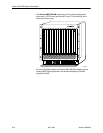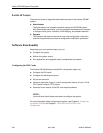
Hotwire DSLAM System Description
1-7
8000-A2-GB26-00
May 1998
Monitoring the DSL Cards
The Hotwire DSLAM software provides submenu options to monitor the activity of
the Hotwire DSL cards. The monitoring screens allow you to:
H List the status of active ports and interfaces in a card, as well as display
statistics about other physical layers and interfaces.
H Display network protocol statistics, such as information about an application
program assigned to a specific socket number, UDP statistics, TCP data and
connection statistics, IP statistics, ICMP packet statistics, and SNMP
statistics including SNMP authentication statistics.
H Display bridging information about the Client, ARP, and VLANs.
H Display endpoint information about DSL ports 1 through 4 such as SN type,
system name, system contact, and system location. Model and serial
number, along with firmware and hardware revisions are also shown.
Use the monitoring screens to help you gather pertinent information and isolate
potential problem areas. You can monitor the system with either Administrator or
Operator permission.
For more information about monitoring the system, see Chapter 6,
Monitoring the
Hotwire DSLAM
.
Troubleshooting and Diagnostics
The Hotwire DSLAM system provides DSL diagnostic submenu options that:
H Display selftest results for CPU health, memory and ports, and resets.
H Show major alarms such as Selftest Failure, Processor Failure, and DSL or
Ethernet port failure.
H Show minor alarms such as Configuration Error or Incorrect SN ports.
H Run a nondisruptive packet echo test over the DSL line.
NOTE:
You must have Administrator permission to perform most of the
troubleshooting and diagnostic activities. However, you can run nondisruptive
tests as a user with operator permission.
For more information about troubleshooting and diagnostics, see Chapter 7,
Diagnostics and Troubleshooting
.


















